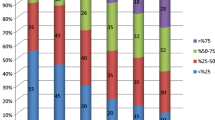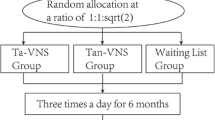Abstract
Purpose
Vagus nerve stimulators (VNS) have emerged as an effective treatment modality for pediatric patients suffering from intractable, drug-resistant epilepsy. Newer devices, AspireSR™ Model 106 and the SenTiva™ Model 1000 (VNS TherapyⓇ, LivaNova™), contain an “auto-stimulation” feature that detects ictal tachycardia and transmits pulsations to attenuate seizures. However, the exact benefits of auto-stimulation compared to its risks still merit further exploration. This study evaluates the utility of these specific devices in a heterogeneous population of pediatric and young adult patients with intractable epilepsy.
Methods
This is a retrospective chart review of 55 patients who underwent either VNS insertion with or without an auto-stimulation-enabled VNS device at a single level four epilepsy center. Seizure frequency, seizure subtype, side effects, and change in anti-seizure medication load both before and after VNS implantations were collected from patient self-reporting at the time of VNS insertion and 12 months following implantation. Information regarding output current, auto-stimulation current, duty cycling, and auto-stimulation threshold of the device was obtained from documented VNS interrogation for patients with auto-stimulation-enabled VNS devices.
Results
Patients with auto-stimulation-enabled VNS devices had a mean 56.0% (SD = 0.414) seizure frequency reduction 12 months post-VNS insertion, while patients without auto-stimulation-enabled VNS devices had a mean 41.6% (SD = 0.456) seizure frequency reduction during the same interval. The mean seizure frequency reduction 12 months post-VNS insertion for patients with a SenTiva™ 1000 model was 66.0% (SD = 0.426). For patients with auto-stimulation-enabled VNS devices, post-treatment seizure reduction was significantly correlated with daily auto-stimulation activation (R = 0.432, p = 0.025).
Conclusion
This study supports the clinical safety and utility of auto-stimulation-enabled VNS models, specifically the SenTiva™ 1000, in treating pediatric patients with intractable epilepsy of various subtypes and etiologies. Further research is needed to evaluate the sustained impact of auto-stimulation on long-term outcomes (≥ 2 years follow-up post-VNS).



Similar content being viewed by others

Availability of data and material
All data generated in this study are included in this published article.
Change history
08 December 2021
Springer Nature’s version of this paper was updated to present the cut-off Table 5 caption in Springerlink.
Notes
FDA Summary of Safety and Effectiveness Data: https://www.accessdata.fda.gov/cdrh_docs/pdf/p970003s207b.pdf
References
Kwan P, Arzimanoglou A, Berg AT, Brodie MJ, Allen Hauser W, Mathern G, Moshé SL, Perucca E, Wiebe S, French J (2010) Definition of drug resistant epilepsy: consensus proposal by the ad hoc Task Force of the ILAE Commission on Therapeutic Strategies. Epilepsia 51(6):1069–1077. https://doi.org/10.1111/j.1528-1167.2009.02397
Hachem LD, Wong SM, Ibrahim GM (2018) The vagus afferent network: emerging role in translational connectomics. Neurosurg Focus 45(3):E2. https://doi.org/10.3171/2018.6.FOCUS18216
Englot DJ, Chang EF, Auguste KI (2011) Vagus nerve stimulation for epilepsy: a meta-analysis of efficacy and predictors of response. J Neurosurg 115(6):1248–1255. https://doi.org/10.3171/2011.7.JNS11977. Epub 2011 Aug 12
Orosz I, McCormick D, Zamponi N, Varadkar S, Feucht M, Parain D, Griens R, Vallée L, Boon P, Rittey C, Jayewardene AK, Bunker M, Arzimanoglou A, Lagae L (2014) Vagus nerve stimulation for drug-resistant epilepsy: a European long-term study up to 24 months in 347 children. Epilepsia 55(10):1576–1584. https://doi.org/10.1111/epi.12762. Epub 2014 Sep 17
Englot DJ, Rolston JD, Wright CW, Hassnain KH, Chang EF (2016) Rates and predictors of seizure freedom with vagus nerve stimulation for intractable epilepsy. Neurosurgery 79(3):345–353. https://doi.org/10.1227/NEU.0000000000001165
Eggleston KS, Olin BD, Fisher RS (2014) Ictal tachycardia: the head-heart connection. Seizure 23(7):496–505. https://doi.org/10.1016/j.seizure.2014.02.012. Epub 2014 Mar 6
Schneider UC, Bohlmann K, Vajkoczy P, Straub HB (2015) Implantation of a new vagus nerve stimulation (vns) therapy® generator, AspireSR®: considerations and recommendations during implantation and replacement surgery–comparison to a traditional system. Acta Neurochir (Wien) 157(4):721–728. https://doi.org/10.1007/s00701-015-2362-3. Epub 2015 Feb 13
Kwan P, Brodie MJ (2000) Early identification of refractory epilepsy. N Engl J Med 342(5):314–319. https://doi.org/10.1056/NEJM200002033420503
Mertens A, Raedt R, Gadeyne S, Carrette E, Boon P, Vonck K (2018) Recent advances in devices for vagus nerve stimulation. Expert Rev Med Devices 15(8):527–539. https://doi.org/10.1080/17434440.2018.1507732
Ben-Menachem E, Mañon-Espaillat R, Ristanovic R, Wilder BJ, Stefan H, Mirza W, Tarver WB, Wernicke JF (1994) Vagus nerve stimulation for treatment of partial seizures: 1. A controlled study of effect on seizures. First International Vagus Nerve Stimulation Study Group. Epilepsia 35(3):616–626. https://doi.org/10.1111/j.1528-1157.1994.tb02482.x
Fisher RS et al (2016) Automatic vagus nerve stimulation triggered by ictal tachycardia: clinical outcomes and device performance–the U.S. E-37 trial. Neuromodulation 19(2):188–195. https://doi.org/10.1111/ner.12376. Epub 2015 Dec 13
Hamilton P, Soryal I, Dhahri P, Wimalachandra W, Leat A, Hughes D, Toghill N, Hodson J, Sawlani V, Hayton T, Samarasekera S, Bagary M, McCorry D, Chelvarajah R (2018) Clinical outcomes of VNS therapy with AspireSR® (including cardiac-based seizure detection) at a large complex epilepsy and surgery centre. Seizure 58:120–126. https://doi.org/10.1016/j.seizure.2018.03.022. Epub 2018 Mar 28
Cukiert A, Cukiert CM, Mariani PP, Burattini JA (2020) Impact of cardiac-based vagus nerve stimulation closed-loop stimulation on the seizure outcome of patients with generalized epilepsy: a prospective, individual-control study. Neuromodulation. https://doi.org/10.1111/ner.13290
Abdelmoity SA, Abdelmoity AA, Riordan SM, Kaufman C, Le Pichon JB, Abdelmoity A (2021) The efficacy and tolerability of auto-stimulation-VNS in children with Lennox-Gastaut syndrome. Seizure 86:168–174. https://doi.org/10.1016/j.seizure.2021.02.015
Murphy JV (1999) Left vagal nerve stimulation in children with medically refractory epilepsy. The Pediatric VNS Study Group. J Pediatr 134(5):563–566. https://doi.org/10.1016/s0022-3476(99)70241-6
Lo WB, Chevill B, Philip S, Agrawal S, Walsh AR (2021) Seizure improvement following vagus nerve stimulator (VNS) battery change with cardiac-based seizure detection automatic stimulation (AutoStim): early experience in a regional paediatric unit. Childs Nerv Syst 37(4):1237–1241. https://doi.org/10.1007/s00381-020-04962-3. Epub 2020 Nov 10
Wheless JW, Gienapp AJ, Ryvlin P (2018) Vagus nerve stimulation (VNS) therapy update. Epilepsy Behav 88S:2–10. https://doi.org/10.1016/j.yebeh.2018.06.032. Epub 2018 Jul 13
Kulju T, Verner R, Dibué-Adjei M, Eronen A, Rainesalo S, Lehtimäki K, Haapasalo J, Peltola J (2020) Circadian distribution of autostimulations in rVNS therapy in patients with refractory focal epilepsy. Epilepsy Behav 110:107144. https://doi.org/10.1016/j.yebeh.2020.107144. Epub 2020 May 27
McHugh JC, Singh HW, Phillips J, Murphy K, Doherty CP, Delanty N (2007) Outcome measurement after vagal nerve stimulation therapy: proposal of a new classification. Epilepsia 48(2):375–378. https://doi.org/10.1111/j.1528-1167.2006.00931
Afra P, Adamolekun B, Aydemir S, Watson GDR (2021) Evolution of the vagus nerve stimulation (vns) therapy system technology for drug-resistant epilepsy. Front Med Technol. https://doi.org/10.3389/fmedt.2021.696543
Peciola S, Himanen SL, Knight A, Dibué-Adjei M, Rainesalo S, Peltola J (2018) Under-reporting of nocturnal seizures using video-based home monitoring: a case study on the evaluation of the effect of vagal nerve stimulation. Epileptic Disord 20(6):535–540. https://doi.org/10.1684/epd.2018.1018
Elger CE, Hoppe C (2018) Diagnostic challenges in epilepsy: seizure under-reporting and seizure detection. Lancet Neurol 17(3):279–288. https://doi.org/10.1016/S1474-4422(18)30038-3
Funding
BS received a stipend from the Zucker School of Medicine at Hofstra/Northwell Office of Medical Student Research. No other external funding was received for the work.
Author information
Authors and Affiliations
Contributions
Conceptualization: BS, SR: recording, analysis, writing: BS, writing—reviewing and editing: SK, SK, SR: Supervision: SR.
Corresponding author
Ethics declarations
Ethics approval
IRB exempt form obtained from the institutional department.
Consent to participate
Not applicable—this is a retrospective review and did not involve patient participation.
Consent for publication
Not applicable—there are no publications of identifiable patient information.
Conflict of interest
The authors have no conflicts of interest to report. The authors are not affiliated with LivaNova™ or Cyberonics™.
Additional information
Publisher's Note
Springer Nature remains neutral with regard to jurisdictional claims in published maps and institutional affiliations.
Rights and permissions
About this article
Cite this article
Santhumayor, B., Karkare, S., Kothare, S. et al. Evaluating vagus nerve stimulation treatment with heart rate monitoring in pediatric patients with intractable epilepsy. Childs Nerv Syst 38, 547–556 (2022). https://doi.org/10.1007/s00381-021-05416-0
Received:
Accepted:
Published:
Issue Date:
DOI: https://doi.org/10.1007/s00381-021-05416-0



